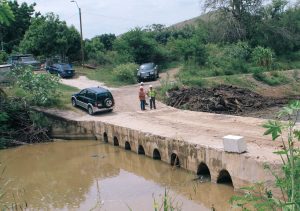Conservation in the Caribbean: Emergency Watershed Protection 07/12/2018
By NACD Southeast Region Representative Phylis Vandevere and USDA-NRCS Caribbean Area Program Analyst Julie Wright
Just days after Hurricanes Irma and Maria, a team of 16 Natural Resources Conservation Service (NRCS) employees from across the country traveled to the Caribbean to assess watershed damages and imminent threats to life and property. The storms were two of the worst natural disasters to ever hit Puerto Rico and the U.S. Virgin Islands (USVI), but the team scouted the islands of Puerto Rico, Culebra, Vieques, St. Croix, St. John and St. Thomas for 45 days to make sure they reached every municipality. With Meal, Ready-to-Eat (MRE) bags and water purification devices in tow, the team oftentimes found themselves camping and helping many residents along the way.
Of the roughly 1,000 sites the team visited, over half qualified for the United States Department of Agriculture’s (USDA) Emergency Watershed Protection (EWP) funding. There were 441 sites identified as Exigency Sites – posing an imminent threat to life or property – for a total estimated cost of $31 million to cover debris removal only with 10 days for the sponsor to complete the work. An additional 130 non-exigency sites were identified with a total estimated cost of $19.3 million, for which disaster survey reports are being completed for debris removal, erosion control, bank stabilization and other conservation practices to restore stream hydrologic function. 
The Emergency Watershed Protection Program (EWPP) helps local communities recover after a natural disaster strikes. The program offers technical and financial assistance to help local communities relieve imminent threats to life and property caused by floods, fires, windstorms and other natural disasters that impair a watershed.
EWPP allows communities to quickly address serious and long-lasting damages to infrastructure and to the land. EWPP authorities offer NRCS the flexibility to act quickly to help local communities cope with adverse impacts resulting from natural disasters. Due to the severe and overwhelming impacts in the Caribbean Area, U.S. Agriculture Secretary Perdue has waived local government matching requirements and extended 100 percent USDA funding of EWPP projects to December 10, 2018.
NRCS offers financial and technical assistance for various activities under EWPP Recovery, including:
- Remove debris from stream channels, road culverts and bridges;
- reshape and protect eroded streambanks;
- correct damaged or destroyed drainage facilities;
- establish vegetative cover on critically eroding lands;
- repair levees and structures; and
- repair conservation practices.
All EWPP Recovery projects begin with a local sponsor or legal subdivision of state or tribal government. Eligible sponsors include cities, counties, towns, conservation districts or any federally-recognized Native American tribe or tribal organization. Interested public and private landowners can apply for EWPP Recovery assistance through one of those sponsors.

In Puerto Rico, the Caribe and Southwest Soil and Water Conservation Districts, along with the Department of Natural & Environmental Resources, are the sponsors for the EWPP projects. In the USVI, the Virgin Islands Department of Public Works is sponsoring EWPP projects. Out of the 441 exigency sites across the islands, about 150 were completed as of our visit. The completion of all 441 exigency sites will protect natural resources, life and property in the Caribbean Area by removing over 300,000 cubic yards of debris from waterways.
Our trip to Puerto Rico last month was truly eye opening. Despite the magnitude of damage the island’s experienced, conservation districts and NRCS employees managed to address issues and continue carrying out the conservation mission. During one of our field days, we visited an EWP site that was constructed to reverse the flow of water under a bridge to not only filter the water, but to prevent flooding the area was experiencing.

As the Southeast Region Representative, I left Puerto Rico recharged and inspired to share our experience with the rest of my region. Not only did we get to meet several of the employees hired through the technical assistance grants NACD and NRCS awarded to the territory, but I was able to put a face to the people who are in the field every day in the Caribbean.
One of the key takeaways from our trip was how eager, passionate and ready Puerto Rico and the USVI are to take advantage of their seat at the table for NACD. I commend these folks for the work they’ve been able to accomplish throughout this devastating time, and I look forward to seeing how their resiliency pays off in the years to come.

